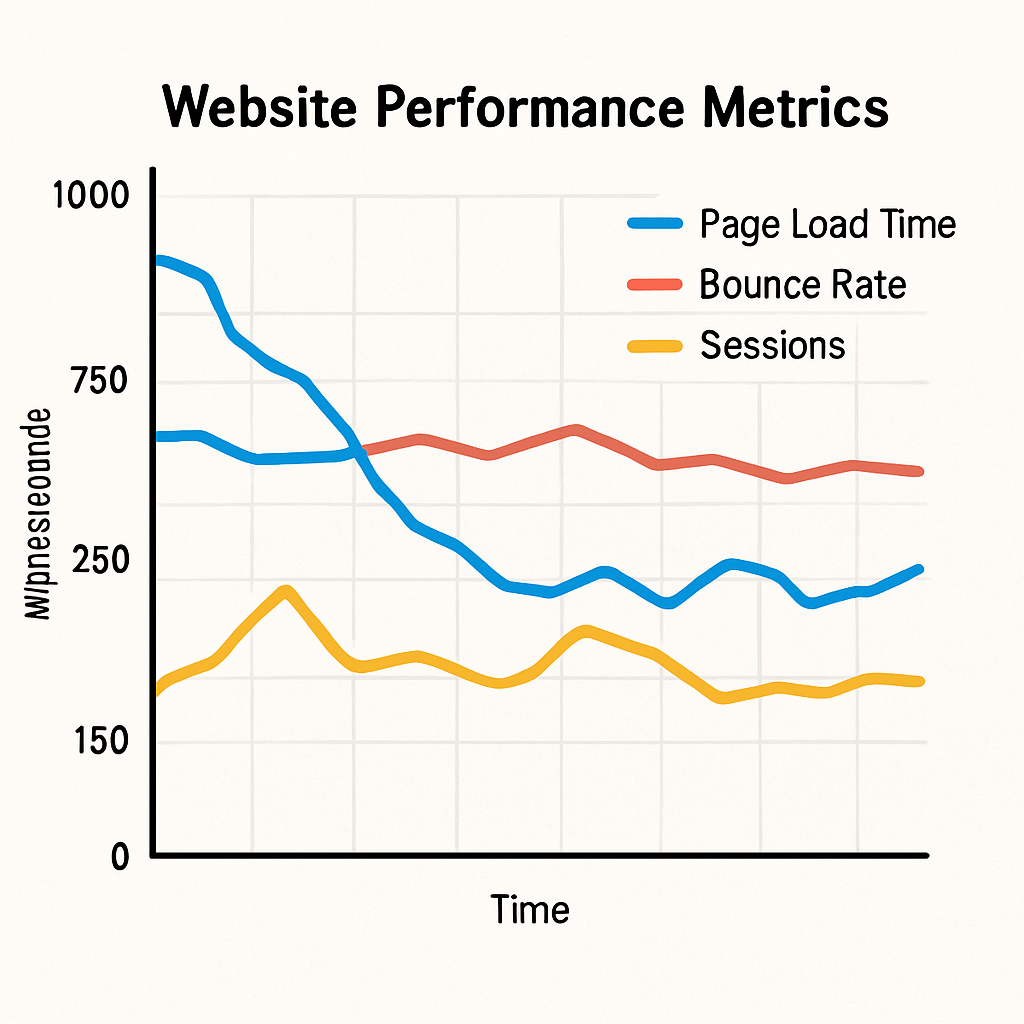Free Website Reviewer: Analyze and Improve Your Site Performance
In today’s digital age, a website’s performance is crucial for business success. Slow load times can drive potential customers away.
A free website performance analyzer can help identify and fix these issues. It offers insights into speed, usability, and security.
By using these tools, you can enhance your site’s user experience. This leads to higher engagement and conversion rates.
Whether you’re an e-commerce owner or a digital marketer, understanding your site’s performance is key. It helps you stay competitive in the online marketplace.
Let’s explore how a free website reviewer can transform your site’s performance and boost your business.
Why Website Performance Matters for Your Business
A website’s performance directly influences its ability to attract and retain customers. Slow websites frustrate users, leading to higher bounce rates.
A swift site enhances user satisfaction, which can improve conversion rates. This ultimately boosts your online sales and reputation.
Performance is also crucial for search engine ranking. Faster sites are more likely to appear at the top of search results, increasing visibility.
In addition to speed, consider these performance aspects:
- Mobile compatibility
- Ease of navigation
- Overall user experience
Optimizing performance isn’t just about speed. It involves ensuring that your website functions well on all devices. A seamless experience for visitors encourages them to return and engage with your brand.
Remember, in the digital space, first impressions matter, and a website’s performance often dictates the initial impression. Taking steps to enhance your site’s speed and usability can significantly impact your business’s bottom line.
What Is a Free Website Performance Analyzer?
A free website performance analyzer is a tool designed to assess various aspects of your website’s functionality. It helps pinpoint issues that may be affecting your site’s speed and user experience. This tool provides insights without incurring costs, making it accessible to businesses of all sizes.
The primary focus of these analyzers is to identify and address elements that can slow down your website. An efficient analyzer offers feedback on multiple critical metrics:
- Page load speed
- Mobile responsiveness
- Security vulnerabilities
Understanding these metrics can help you make informed improvements, boosting your site’s overall performance. It also aids in ensuring your site remains competitive in the digital landscape.
Utilizing a free website performance analyzer regularly can ensure that your website meets the fast-evolving expectations of users and search engines. An optimized website not only performs better but also helps in enhancing user experience, leading to increased customer satisfaction.
Key Features of Top Website Analysis Tools
Top website analysis tools are equipped with a wide array of features that cater to various needs. Their comprehensive capabilities help businesses optimize their online presence effectively. Key functions of these tools go beyond basic speed checks.
Firstly, they provide in-depth SEO analysis to enhance search engine visibility. These tools identify keyword opportunities and suggest content improvements. This is crucial for attracting the right audience.
Moreover, they offer detailed security assessments to protect sensitive data from cyber threats. These features are vital in maintaining user trust and compliance with digital standards. Many tools also evaluate site usability, ensuring easy navigation and a positive user experience.
Essential features often include:
- Real-time performance monitoring
- SEO audit tool integration
- Detailed user interaction insights

Lastly, these tools generate clear, actionable reports for businesses to make data-driven decisions. They prioritize fixes that have the most significant impact on performance. By leveraging these features, businesses can ensure their websites remain competitive and user-friendly.
How to Use a Free Website Performance Analyzer: Step-by-Step Guide
Using a free website performance analyzer is straightforward yet impactful. It helps identify areas of your website that need improvement. Below is a step-by-step guide to get you started.
Begin by choosing a reliable website performance testing tool. Some popular options include Google PageSpeed Insights and GTmetrix. These tools provide comprehensive insights into your website’s speed and performance.
Next, input your website’s URL in the tool’s search box. This step initiates the analysis of various metrics related to your site’s health and efficiency.
Once the analysis is complete, review the results carefully. The tool will display scores and a detailed breakdown of different performance factors.
Typical areas of focus include page load times, server response time, and resource optimization. Identifying bottlenecks is crucial for making effective improvements.
Follow the actionable recommendations provided by the tool. These often include optimizing images, leveraging browser caching, and reducing server response time.
To illustrate, here’s a checklist to guide you:
- Choose the right analyzer
- Enter your website URL
- Review results and scores

- Implement recommended improvements
- Rerun tests to track progress

Finally, consistently monitor your website’s performance. Regular checks ensure sustained improvements and help you adapt to any changes in user demand or technology trends. This proactive approach will significantly enhance your website’s efficiency and user experience.
Essential Metrics to Monitor in Your Website Performance Test
Understanding the right metrics is crucial for evaluating website performance. These indicators help pinpoint issues and guide improvements. Monitoring them can significantly enhance user experience and SEO outcomes.
Page Load Time is a critical metric. Faster loading pages retain visitors better and improve search engine rankings. Aim for a load time of under three seconds for optimal results.
Server Response Time impacts how quickly users can start interacting with your site. Delays here can frustrate visitors. Regularly check and optimize your server’s efficiency.
First Contentful Paint (FCP) measures how long it takes for the first piece of content to appear. This metric indicates the perceived performance from the user’s perspective.
Bounce Rate reflects the percentage of visitors leaving after viewing just one page. High bounce rates often suggest issues with content relevance or technical glitches.
Here’s a summarized list of key metrics:
- Page Load Time
- Server Response Time
- First Contentful Paint
- Bounce Rate
By keeping a keen eye on these metrics, you can make data-driven decisions. These decisions directly improve your website’s functionality and user engagement.

Improving Site Speed: Actionable Tips from Your Website Speed Test
Speed is a vital element for any website’s success. Slow sites frustrate users and can lose potential customers. Use data from your website speed test to make informed improvements.
Start with image optimization. Large image files slow down your site considerably. Compress images without losing quality and consider using next-gen formats like WebP.
Another tip is to leverage browser caching. Caching stores files locally on users’ devices, reducing load times for returning visitors. Review your caching settings to ensure they are properly configured.
Minify CSS, JavaScript, and HTML to remove unnecessary spaces and comments. This streamlines your code and enhances load times. Many online tools can automate this task for you.
Keep these actionable tips in mind:
- Optimize images
- Leverage browser caching
- Minify CSS, JavaScript, and HTML
By implementing these changes, you’ll see noticeable improvements in load speeds.
A fast site not only pleases users but also boosts your search rankings, leading to increased traffic and conversions.

Beyond Speed: Usability, Security, and SEO Insights
Improving website speed is just the beginning. To create a comprehensive online presence, consider usability, security, and SEO. These factors play a crucial role in user engagement and trust.
Usability is about making your site easy to navigate. Visitors should find what they’re looking for without frustration. Conduct a website usability checker test to identify navigation issues or layout problems.
Security protects your website and its users. Regular website security scans help detect vulnerabilities like malware, ensuring your site remains safe and credible. Address any security gaps promptly.
SEO insights are key to improving your site’s visibility. An SEO audit tool can reveal keyword opportunities and areas for content enhancement, aligning your website with search engine algorithms.
These aspects are integral to robust website health:
- Usability checks
- Security scans
- SEO audits
Focus on these areas to provide a holistic user experience that encourages loyalty and trust.

Comparing the Best Free Website Review Tools
Choosing the right website review tool is essential for improving site performance. Many free options offer various insights to help optimize your site effectively. Let’s explore some of the best available.
Google PageSpeed Insights delivers comprehensive speed and optimization data. It identifies areas for improvement and provides performance scores for both desktop and mobile. This tool is ideal for a quick analysis of load times and responsiveness.
GTmetrix offers detailed insights into page load speed and structure. Its reports highlight key metrics such as page sizes and requests. GTmetrix also offers recommendations to optimize specific elements.
Pingdom Website Speed Test focuses on analyzing load times, performance grades, and identifying bottlenecks. It’s known for its user-friendly interface and in-depth analysis.
Here’s a quick comparison:
- Google PageSpeed Insights: Speed and optimization reports
- GTmetrix: Detailed speed and structural analysis
- Pingdom: Performance grades and load time insights
Explore these tools to find the best fit for your needs.


Frequently Asked Questions About Website Performance Testing
Why is website performance testing important? Performance testing ensures your site loads quickly and efficiently, which is crucial for user satisfaction and SEO rankings.
What tools can I use for free testing? Many free tools are available, including Google PageSpeed Insights and GTmetrix. Each offers unique insights into different aspects of website performance.
How often should I test my website? Regular testing is vital, ideally after any significant updates. Consistent checks ensure your site remains optimized and responsive to changes.
Common questions include:
- What do performance grades mean?
- How can I improve page load speed?
- What should I focus on besides speed?
Understanding these aspects helps maintain a well-performing site. Regular monitoring and improvements are key.
Conclusion: Take Action to Boost Your Site’s Performance
In today’s digital age, a fast and efficient website is vital. Implementing insights from a free website performance analyzer can significantly enhance your site’s functionality and user satisfaction.
Taking proactive steps to address speed, security, and usability ensures better engagement and competitiveness. By regularly monitoring and optimizing your site, you set the stage for increased conversions and customer loyalty. Start now, and witness the transformative impact on your online presence. Remember, continual improvement is key to online success.



Add comment
You must be logged in to post a comment.